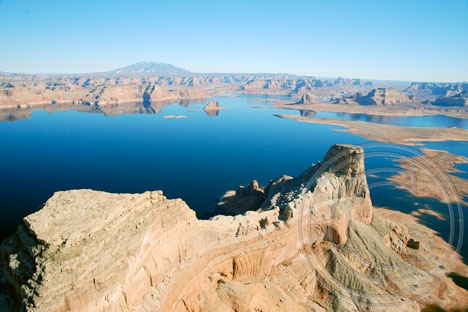A comment turned into a blog post.
I just read “The Shot” on Helicopter Pilot, Will Travel. (If you’re a helicopter pilot and you don’t read this blog, you’re really missing out on something valuable.) The post was about aerial photography and the difficulties in getting good shots.

I was a passenger in a friend’s R44 when I snapped this photo.
It was the best image of about two dozen attempts.
I started to write a comment on the post, but soon had more words than a polite commenter should be leaving on someone else’s blog. So I figured I’d just turn my blather into my own blog post on the subject.
I do a lot of flying with photographers and video folks on board. A lot of it is “fine art” photography in places like Lake Powell and Canyonlands National Park. There’s also some commercial photography — bridges, highways, buildings, etc. And lots of “action” photography and video of racing boats and off-road trucks.
I absolutely love this kind of work — especially the high-speed chase stuff. It gives me an opportunity to get “in the zone” with the aircraft. I usually sit the photographer in the seat behind me so we get the same view. This makes it easy to stay on the target.
It gets challenging when slow flight is required — especially if it’s windy or if we’re in high density altitude. I’ve gotten to the point where I know when to expect a settling with power situation and can recover from it quickly, with the minimum loss of altitude. I’m also smart enough to avoid it any time I’m flying low-level.
The quality of the photographer’s work varies greatly. There’s a video guy I work with on off-road races that’s incredible. The four of us — me, my helicopter, the video guy, and an up-front observer — make an excellent team. I’m not sure if it’s my ability to fly close to the racing vehicles or his ability to manipulate the camera — probably a combination of both — but his footage is mind-boggling.
The fine art photographers’ work depends on lighting and where we’re taking the photos. The southwest U.S. landscape is amazing, but early in the morning, just after dawn, or late in the afternoon, just before sunset, I really think it’s impossible to take a bad photo.
You can tell the experienced aerial photographers from the newbies by the equipment they bring — mostly lenses. I’ve had people show up with zoom lenses that not only forced me to fly far from the subject matter to get it to “fit” in the lens, but let in so little light that shutter speed was an issue.
On the other side of the coin is a photographer that always mounts his camera on a hand-held gyro stabilizer to minimize the vibrations coming in from the helicopter. I’m actually thinking of investing in one of these devices, so I can rent it to the photographers that fly with me. Being more flexible with shutter speed would give them more flexibility in terms of composition.
Unfortunately, I seldom get to try my own hand at aerial photography. You see, both hands are usually busy with the controls in my single-pilot R44. I did get an opportunity to fly with a fellow pilot in his R44 in Washington State last summer (see combine photo above), but more recently, I’ve begun doing some doors-off flying with my husband, who is also a helicopter pilot. We take turns playing with the camera. The shot accompanying this post is one of mine from a recent flight to Lake Powell.
One thing Keith is certainly right about in his post — it can take an awful lot of tries to get just the right photo.




 To give you an idea of what I’m working with and how I’m dealing with it, consider the screen shots here. The first shot shows a frame of a movie I’m reviewing. I converted its original high definition format to QuickTime for easy viewing. The movie was shot from my helicopter while flying over Lake Powell. It shows a particular stretch of shoreline. I need to know — at least approximately — where on the 135-mile long lake this shoreline is.
To give you an idea of what I’m working with and how I’m dealing with it, consider the screen shots here. The first shot shows a frame of a movie I’m reviewing. I converted its original high definition format to QuickTime for easy viewing. The movie was shot from my helicopter while flying over Lake Powell. It shows a particular stretch of shoreline. I need to know — at least approximately — where on the 135-mile long lake this shoreline is. Here’s the same place on Google Maps. And yes, I’m sure it’s the same place.
Here’s the same place on Google Maps. And yes, I’m sure it’s the same place.